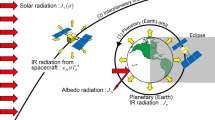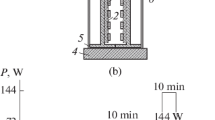Abstract
The problem of maintenance of the equipotentiality of spacecraft surfaces is considered. The method under examination is the use of the “conductive thermal-vacuum multilayer blanket” (CMLB), whose outer surface represents a fabric woven of threads of glass fiber type with interwoven metal threads. The process of spacecraft potential formation and methods of the potential calculation are described, and the results of such a calculation for the illuminated and shadowed parts of spacecraft surfaces in some characteristic near-Earth plasma environments are presented. The CMLB model is described, and the potential distribution near the CMLB surface is calculated. The conclusion was drawn that the conductive thermal-vacuum multilayer blanket used in some cases on Russian spacecraft does not ensure the equipotentiality of spacecraft surfaces, and in the case of using CMLB, the differential spacecraft charging in outer regions of the Earth's magnetosphere may reach a dangerous level for onboard electronic systems. In spite of the fact that CMLB guards against large-scale powerful discharges, one cannot exclude discharges completely, what may result in broadband noise enhancement and cause onboard systems failures.
Similar content being viewed by others
REFERENCES
DeForest, S.E., Spacecraft Charging at Synchronous Orbit, J. Geophys. Res., 1972, vol. 77, p. 651.
Olsen, R.C., Record Charging Events from Applied Technology Satellite 6, J. Spacecraft. Rockets, 1987, vol.24, p. 362.
Frooninckx, T.B. and Sojka, J.J., Solar Cycle Dependence of Spacecraft Charging in Low Earth Orbit, J. Geophys. Res.,1992, vol. 97, no. 3, pp. 2985–2996.
Afonin, V., On the Spacecraft Photo-Emission Efficiency in the Inner Magnetosphere, Adv. Space Res., 2003, vol. 31, no.5, pp. 1217–1222.
Grard, R.J.L., Properties of the Satellite Photoelectron Sheath Derived from Photoemission Laboratory Measurements, J. Geophys. Res.,1973, vol. 78, no. 16, pp.2885–2906.
Escoubet, C.P., Pedersen, A., Schmidt, R., and Lindqvist, P.-A. Density in the Magnetosphere Inferred from ISEE 1 Spacecraft Potential, J. Geophys. Res.,1997, vol. 102, pp. 17595–17609.
Scudder, J.D., Cao, X., and Mozer, F.S., The Photoemission Current-Spacecraft Voltage Relation: Key to Routine, Quantitative Low Energy Plasma Measurements, J. Geophys. Res., 2000, vol. 105, pp. 21, 281.
Afonin, V.V., Akentieva, O.S., and Smilauer, J., Interball-2Measurements of the Components of Thermal and Suprathermal Plasma (E< 15 eV) in High-Latitude Regions of the Magnetosphere at Altitudes of 2-3 R E, Kosm. Issled., 2000, vol. 38, no. 5, pp. 515–523.
MPSL: Magnetospheric Plasma Sources and Losses, Hultquist, B., Oieroset, M., Pashman, G., and Treuman, R., Eds., Dortrecht-Boston-London: Kluwer Academic, Reprinted from Space Science Reviews, 1999, vol. 88, Nos. 1-2.
Kozlov, A.I., Galperin, Yu.I., Gladyshev, V.A., and Mulyarchik, T.M., The ANOD Experiment for Long-Term Tests of Solar Panels in the Interball-2Satellite Orbit, Kosm. Issled., 1999, vol. 37, no. 6, pp. 573–580.
Pedersen, A., Solar Wind and Magnetosphere Plasma Diagnostics by Spacecraft Electrostatic Potential Measurements, Ann. Geophys., 1995, vol. 13, no. 2, pp. 118–129.
Author information
Authors and Affiliations
Rights and permissions
About this article
Cite this article
Afonin, V.V. The Potential and Equipotentiality of Spacecraft. Cosmic Research 42, 32–38 (2004). https://doi.org/10.1023/B:COSM.0000017559.84665.90
Issue Date:
DOI: https://doi.org/10.1023/B:COSM.0000017559.84665.90




